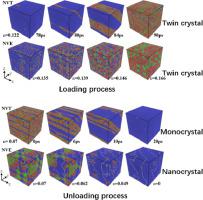当前位置:
X-MOL 学术
›
Int. J. Mech. Sci.
›
论文详情
Our official English website, www.x-mol.net, welcomes your
feedback! (Note: you will need to create a separate account there.)
Reversibility of the structural transition in single crystal iron driven by uniaxial and triaxial strains: atomistic study
International Journal of Mechanical Sciences ( IF 7.1 ) Pub Date : 2021-02-01 , DOI: 10.1016/j.ijmecsci.2020.106064 Xiu-Xia Guo , Jian-Li Shao , Guo Lu
International Journal of Mechanical Sciences ( IF 7.1 ) Pub Date : 2021-02-01 , DOI: 10.1016/j.ijmecsci.2020.106064 Xiu-Xia Guo , Jian-Li Shao , Guo Lu

|
Abstract Atomistic simulations are used to investigate the structural transition (ST) in single crystal iron and its reverse process in isothermal (NVT) and adiabatic (NVE) ensembles. The hysteresis and microstructural reversibility of the ST are examined in detail. Under [001] uniaxial loading, we observe HCP twins oriented along the original {010} (T1) and {110} planes (T2) of BCC phase after twice HCP nucleation. Interestingly, T2 HCP twins will be annexed by T1 HCP twins with the increase of compression strain. Due to the strain rate effect, the start stress of ST and the nucleation number in NVE ensemble increase. In the unloading process, T2 HCP twins will reappear and BCC nucleation begins at the T2 twinning plane. The reverse ST in NVE ensemble begins earlier because of temperature rise, but ends at a later time. These analyses show that the [001] uniaxial strain-driven ST exhibits good microstructure reversibility with some hysteresis. Under triaxial loading, lamellar twins of HCP-FCC mixed phase along the {110} planes of BCC phase are found in NVT ensemble, where the start pressure of ST is much higher than that under [001] loading. BCC phase will nucleate at the grain boundaries in the unloading process. In NVE ensemble, plenty of nucleation takes place on the equivalent closed-packed planes and results in very small parallelepiped grains. Finally, BCC nanocrystals are formed after complete unloading, indicating an irreversibility of microstructure driven by triaxial strain at the high strain rate.
中文翻译:

单轴和三轴应变驱动的单晶铁结构转变的可逆性:原子研究
摘要 原子模拟用于研究单晶铁的结构转变 (ST) 及其在等温 (NVT) 和绝热 (NVE) 系综中的逆过程。详细检查了 ST 的滞后和微观结构可逆性。在[001]单轴加载下,我们观察到HCP孪晶在两次HCP成核后沿BCC相的原始{010}(T1)和{110}面(T2)取向。有趣的是,随着压缩应变的增加,T2 HCP 双胞胎将被 T1 HCP 双胞胎吞并。由于应变率效应,ST 的起始应力和 NVE 系综中的成核数增加。在卸载过程中,T2 HCP 孪晶将重新出现,BCC 成核开始于 T2 孪晶面。由于温度升高,NVE 系综中的逆 ST 开始得更早,但结束得更晚。这些分析表明,[001] 单轴应变驱动的 ST 表现出良好的微观结构可逆性和一些滞后。在三轴加载下,在 NVT 系综中发现 HCP-FCC 混合相的层状孪晶沿 BCC 相的 {110} 面,其中 ST 的起始压力远高于 [001] 加载下的压力。BCC 相将在卸载过程中在晶界处形核。在 NVE 集合中,大量的成核发生在等效的密堆积平面上,并导致非常小的平行六面体晶粒。最后,完全卸载后形成 BCC 纳米晶体,表明在高应变速率下三轴应变驱动的微观结构不可逆。在 NVT 系综中发现了 HCP-FCC 混合相沿 BCC 相 {110} 平面的层状孪晶,其中 ST 的起始压力远高于 [001] 加载下的压力。BCC 相将在卸载过程中在晶界处形核。在 NVE 集合中,大量的成核发生在等效的密堆积平面上,并导致非常小的平行六面体晶粒。最后,完全卸载后形成 BCC 纳米晶体,表明在高应变速率下三轴应变驱动的微观结构不可逆。在 NVT 系综中发现了 HCP-FCC 混合相沿 BCC 相 {110} 平面的层状孪晶,其中 ST 的起始压力远高于 [001] 加载下的压力。BCC 相将在卸载过程中在晶界处形核。在 NVE 集合中,大量的成核发生在等效的密堆积平面上,并导致非常小的平行六面体晶粒。最后,完全卸载后形成 BCC 纳米晶体,表明在高应变速率下三轴应变驱动的微观结构不可逆。大量的成核发生在等效的密堆积平面上,并导致非常小的平行六面体晶粒。最后,完全卸载后形成 BCC 纳米晶体,表明在高应变速率下三轴应变驱动的微观结构不可逆。大量的成核发生在等效的密堆积平面上,并导致非常小的平行六面体晶粒。最后,完全卸载后形成 BCC 纳米晶体,表明在高应变速率下三轴应变驱动的微观结构不可逆。
更新日期:2021-02-01
中文翻译:

单轴和三轴应变驱动的单晶铁结构转变的可逆性:原子研究
摘要 原子模拟用于研究单晶铁的结构转变 (ST) 及其在等温 (NVT) 和绝热 (NVE) 系综中的逆过程。详细检查了 ST 的滞后和微观结构可逆性。在[001]单轴加载下,我们观察到HCP孪晶在两次HCP成核后沿BCC相的原始{010}(T1)和{110}面(T2)取向。有趣的是,随着压缩应变的增加,T2 HCP 双胞胎将被 T1 HCP 双胞胎吞并。由于应变率效应,ST 的起始应力和 NVE 系综中的成核数增加。在卸载过程中,T2 HCP 孪晶将重新出现,BCC 成核开始于 T2 孪晶面。由于温度升高,NVE 系综中的逆 ST 开始得更早,但结束得更晚。这些分析表明,[001] 单轴应变驱动的 ST 表现出良好的微观结构可逆性和一些滞后。在三轴加载下,在 NVT 系综中发现 HCP-FCC 混合相的层状孪晶沿 BCC 相的 {110} 面,其中 ST 的起始压力远高于 [001] 加载下的压力。BCC 相将在卸载过程中在晶界处形核。在 NVE 集合中,大量的成核发生在等效的密堆积平面上,并导致非常小的平行六面体晶粒。最后,完全卸载后形成 BCC 纳米晶体,表明在高应变速率下三轴应变驱动的微观结构不可逆。在 NVT 系综中发现了 HCP-FCC 混合相沿 BCC 相 {110} 平面的层状孪晶,其中 ST 的起始压力远高于 [001] 加载下的压力。BCC 相将在卸载过程中在晶界处形核。在 NVE 集合中,大量的成核发生在等效的密堆积平面上,并导致非常小的平行六面体晶粒。最后,完全卸载后形成 BCC 纳米晶体,表明在高应变速率下三轴应变驱动的微观结构不可逆。在 NVT 系综中发现了 HCP-FCC 混合相沿 BCC 相 {110} 平面的层状孪晶,其中 ST 的起始压力远高于 [001] 加载下的压力。BCC 相将在卸载过程中在晶界处形核。在 NVE 集合中,大量的成核发生在等效的密堆积平面上,并导致非常小的平行六面体晶粒。最后,完全卸载后形成 BCC 纳米晶体,表明在高应变速率下三轴应变驱动的微观结构不可逆。大量的成核发生在等效的密堆积平面上,并导致非常小的平行六面体晶粒。最后,完全卸载后形成 BCC 纳米晶体,表明在高应变速率下三轴应变驱动的微观结构不可逆。大量的成核发生在等效的密堆积平面上,并导致非常小的平行六面体晶粒。最后,完全卸载后形成 BCC 纳米晶体,表明在高应变速率下三轴应变驱动的微观结构不可逆。











































 京公网安备 11010802027423号
京公网安备 11010802027423号